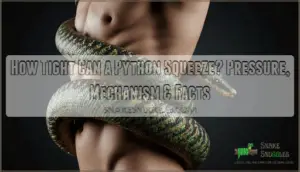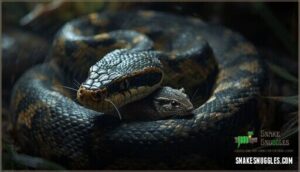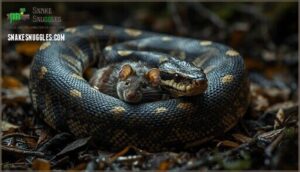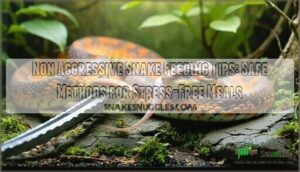This site is supported by our readers. We may earn a commission, at no cost to you, if you purchase through links.
 A reticulated python’s coils can generate up to 7.8 pounds per square inch of pressure—enough to stop your heart in seconds. That’s not a figure of speech. When a python wraps around its prey, it’s not crushing bones or suffocating lungs. It’s targeting something far more critical: your circulatory system.
A reticulated python’s coils can generate up to 7.8 pounds per square inch of pressure—enough to stop your heart in seconds. That’s not a figure of speech. When a python wraps around its prey, it’s not crushing bones or suffocating lungs. It’s targeting something far more critical: your circulatory system.
The snake detects your heartbeat through its coiled muscles, adjusting its grip with each pulse until blood stops flowing to your brain. Within six seconds, peripheral blood flow drops by half. Death follows from circulatory collapse, not lack of air.
Understanding how pythons squeeze reveals a predatory mechanism millions of years in the making, one that turns muscle power and sensory precision into one of nature’s most efficient killing methods.
Table Of Contents
- Key Takeaways
- How Tight Can a Python Squeeze?
- Factors Affecting The Strength of a Python’s Constriction
- How Does a Python Constrict Its Prey?
- What Happens When a Python Squeezes?
- The Pressure Exerted by Different Python Species
- How Does a Python Know When to Stop Constricting?
- Research on Snake Constriction Mechanism
- The Relationship Between Constriction and Snake’s Metabolism
- Evolutionary Adaptations in Snake Constriction
- The Importance of Detecting Prey’s Heartbeat for Energy Conservation
- Frequently Asked Questions (FAQs)
- Are pet pythons dangerous?
- What is the difference between anacondas and pythons?
- Can alcohol help a snake release its grip?
- How does size affect a python’s constriction?
- Is constriction more effective against endothermic or ectothermic animals?
- Can pythons squeeze humans to death?
- How do pythons breathe while constricting prey?
- Do pythons break bones during constriction?
- Can a python release its grip voluntarily?
- How long does a python squeeze prey?
- Conclusion
Key Takeaways
- Pythons kill prey through circulatory collapse, not suffocation—constriction pressures of 1.2 to 7.8 PSI shut down blood flow within six seconds, causing cardiac arrest in 60 to 90 seconds rather than blocking airways.
- A python’s squeezing force scales directly with body diameter and size, with larger specimens generating exponentially more pressure through increased muscle cross-sections (reticulated pythons over 4 meters produce three times the force of 2-meter individuals).
- Pythons use specialized mechanoreceptors along their coils to detect prey heartbeats in real-time, adjusting grip pressure dynamically and releasing immediately after cardiac arrest to conserve energy—constriction burns seven times their resting metabolic rate.
- The evolutionary advantage of heartbeat detection allows pythons to conserve 20–40% of muscular energy by knowing exactly when to stop constricting, making this sensory adaptation essential for survival between infrequent meals.
How Tight Can a Python Squeeze?
How tight can a python actually squeeze? Reticulated pythons generate peak constriction pressures between 1.2 and 7.8 pounds per square inch (psi), depending on their body diameter and muscle mass. Burmese pythons exert slightly less force, ranging from 2.6 to 6.2 psi, while smaller ball pythons produce around 4.0 psi.
These pressure measurements reveal that constriction strength scales directly with body size—larger snakes possess greater muscle cross-sections, allowing them to apply exponentially more squeezing force. According to recent studies, prey dies due to over-pressurization of the brain.
Researchers use specialized pressure measurement devices to capture these values during live constriction events, demonstrating that even modest constricting strength far exceeds mammalian blood pressure thresholds, ensuring rapid circulatory collapse in prey.
Factors Affecting The Strength of a Python’s Constriction
Not all pythons squeeze with the same force, and several key factors determine just how powerful their constriction can be. Body thickness, overall size, and even the prey’s characteristics all play a role in how much pressure a python can generate.
Let’s look at the three main factors that affect a python’s squeezing strength.
Body Thickness
When you’re looking at a python’s body, diameter matters more than you might think. Thicker snakes pack more muscle into their cross-sectional area, which translates directly into crushing power. Research shows constriction pressure increases at roughly 1.39 to 1.42 kPa per centimeter of diameter in reticulated and Burmese pythons.
Here’s how body thickness influences constricting strength:
- Pressure Scaling: Ball pythons demonstrate that larger diameters are the only statistically significant predictor of constriction strength, with peak pressures in adult reticulated pythons ranging from 8.27 to 53.77 kPa depending on individual thickness.
- Muscle Density: Thicker-bodied snakes generate disproportionately higher force because muscle fiber density increases relative to diameter, not just overall mass.
- Species Comparison: While anacondas can reach extreme pressures near 90 PSI due to their massive girth, typical pythons measure between 4.0 PSI (ball pythons) and 7.8 PSI (reticulated pythons). The scaling of constriction pressure is further detailed in scientific studies.
Understanding this relationship between snake diameter and pressure helps explain why some species are far more effective hunters than others.
Size of The Python
Beyond diameter alone, the overall size of the python plays a major role in determining how much force it can deliver. Reticulated pythons over 4 meters long generate more than three times the pressure of 2-meter individuals. Burmese pythons show a clear link between length and pressure output, with larger specimens consistently outperforming smaller ones.
| Snake Size | Constriction Pressure |
|---|---|
| Juvenile ball pythons | Below 18 kPa |
| Adult ball pythons | Above 40 kPa |
| 2 m reticulated pythons | Baseline pressure |
| 4+ m reticulated pythons | 3× baseline pressure |
Giant snakes don’t just hit harder—they also cover more surface area when coiling, giving them better control over larger prey. This scaling performance improves continuously as the snake grows, meaning a bigger body translates directly into better hunting capability, not just through experience but through pure physical advantage.
Prey Size and Heart Rate
It’s not just size that matters—pythons fine-tune their grip based on what they’re squeezing and how hard it’s fighting back. When you’re dealing with larger prey or an animal with a racing heart, the snake ramps up the pressure, sometimes doubling its force to bring about faster incapacitation. Studies show that pressures between 20 and 45 kPa can shut down the circulatory system within seconds, depriving key organs of oxygen and causing complete cardiac arrest.
Pythons adjust dynamically throughout the kill, tightening their coils in sync with the prey’s heartbeat irregularities and easing off once cardiac activity stops. They detect this feedback through mechanosensory receptors that pick up on struggling intensity and pulse patterns, allowing precise pressure modulation without wasting energy.
Key factors influencing constriction response include:
- Prey mass: Larger animals trigger stronger constriction effort to achieve arrest pressure quickly
- Heart rate variability: Irregular or elevated cardiac activity prompts tighter coiling
- Struggling intensity: Active resistance increases applied force to maintain control
- Size matters principle: Bigger prey demands proportionally greater pressure for effective subdual
How Does a Python Constrict Its Prey?
When a python strikes, it immediately wraps its powerful trunk muscles around its prey, forming one to four tight coils that restrict blood flow within seconds. This snake constriction mechanism relies on muscle power and sensory feedback to deliver lethal coil pressure targeting the prey’s circulatory system rather than suffocating it.
Python constriction techniques involve three critical stages:
- Strike and coil: The python pulls its prey into its loops after the initial bite, positioning coils over major blood vessels to disrupt circulation
- Pressure application: Constriction pressure causes peripheral arterial blood flow to drop by 50% within just six seconds, while central venous pressure increases sixfold
- Cardiac monitoring: Through sensory feedback along its body, the snake detects the prey’s heartbeat and maintains pressure until cardiac arrest occurs
Understanding how a python constricts reveals that death results from circulatory collapse, not suffocation. Snake constriction behavior demonstrates striking efficiency—the python adjusts its squeeze based on what it senses, releasing only when the heart stops beating.
What Happens When a Python Squeezes?
When a python squeezes, blood flow stops almost instantly—peripheral circulation drops by 50% within six seconds while central venous pressure spikes sixfold. This circulatory arrest leads to cardiac arrest in prey within 60 to 90 seconds, not suffocation as once believed.
When a python squeezes, blood flow stops within seconds, causing cardiac arrest in prey through circulatory collapse rather than suffocation
The constriction pressures, ranging from 8.27 to 53.77 kPa, far exceed prey blood pressure and can cause neural damage, tissue trauma, and even the "red-out effect" from cerebral over-pressurization. Respiratory failure follows as organs shut down from oxygen deprivation.
You’re witnessing a precisely calibrated killing mechanism that ensures rapid prey death through vascular collapse.
The Pressure Exerted by Different Python Species
Not all pythons squeeze with the same force. The pressure each species can generate depends on its body size, muscle mass, and overall build.
Here’s what you need to know about three of the most powerful constrictors.
Reticulated Python
Regarding raw constriction force, reticulated pythons rank among the most powerful constrictors on the planet. These massive snakes can exert up to 7.8 PSI (53.77 kPa) of pressure during feeding events, with field measurements showing peak forces ranging from 8.27 to 53.77 kPa depending on the individual’s size. A 23-foot specimen once generated around 6 PSI when constricting a pig—enough to cause rapid circulatory collapse.
Here’s what makes their constriction so effective:
- Size-dependent scaling: Larger reticulated pythons produce exponentially greater pressures, with constriction force increasing linearly as body diameter grows (pressure = 15.17 + diameter × 1.39).
- Habitat-driven prey selection: Their widespread habitat range across Southeast Asia means they’ve adapted to subdue diverse prey, from wild pigs to deer, requiring consistently high constriction pressure.
- Energy-efficient killing: Using pressure transducers, researchers like Dr. Scott Boback discovered that reticulated pythons adjust their grip based on prey heartbeat detection, applying just enough force to induce cardiac arrest while conserving metabolic energy.
Despite their conservation status facing threats from habitat loss, these top predators remain masters of controlled, lethal pressure.
Burmese Python
Regarding sheer crushing force, Burmese pythons can generate up to 6.23 PSI (42.93 kPa) of constriction pressure—enough to collapse your circulatory system in seconds. Lab studies reveal their mean pressure ranges from 18.0 to 42.93 kPa, with larger individuals delivering considerably higher forces following the formula: pressure = 17.7 + diameter × 1.42.
Dr. Scott Boback’s research shows these snakes use prey death mechanisms linked to heartbeat detection, adjusting their grip to induce cardiac arrest efficiently.
Despite their invasive species status in Florida and conservation status challenges elsewhere, Burmese pythons remain formidable constrictors. Their Burmese morphology—thick coils packed with muscle—makes them particularly effective hunters across diverse diet analysis studies.
African Rock Python
Regarding sheer size and raw constriction force, the African Rock Python stands out as one of Africa’s most powerful constrictors. While direct measurements are limited, these giants are estimated to match reticulated and Burmese pythons in constriction pressure—likely reaching 6–8 PSI based on comparable body diameters. Their prey death mechanisms are striking, with documented kills including antelope and even young crocodiles, animals with chest girths exceeding 100 cm.
Key factors defining their constriction capabilities:
- Size Comparison: Reaching up to 20 feet, they’re among Africa’s largest snakes, with muscle mass enabling forces sufficient to collapse major cardiovascular systems
- African Diet: Their prey selection—often exceeding 40 kg—demonstrates constriction force capable of subduing dangerous animals
- Habitat Range: Distributed across sub-Saharan Africa, their snake constriction mechanism has adapted to diverse prey with varying circulatory demands
- Conservation Status: Despite habitat pressures, their Temperament Traits remain formidable, making them top predators wherever they occur
How Does a Python Know When to Stop Constricting?
You might wonder how a constricting snake knows the exact moment to release its prey. The answer lies in specialized mechanoreceptor functions embedded along their coils, which detect prey heartbeats through minute vibrations. This striking sensory capability represents millions of years of evolutionary origins, honing prey detection into a precise art.
Here’s how heartbeat detection guides their lethal embrace:
- Mechanoreceptors sense cardiac cessation – These pressure-sensitive nerve endings detect when the prey’s heart stops, signaling circulatory and neural function failure within minutes.
- Energy conservation drives release timing – Constriction burns seven times the normal metabolic rate, so detecting prey death prevents wasteful over-squeezing that exposes them to exhaustion.
- Learned behavior enhances innate skill – Even naive snakes respond to heartbeats instinctively, but experienced hunters improve pressure based on sensory cues from different prey sizes.
- Doubled pressure when hearts beat – Experiments show constrictors apply 15–20 kPa more force and squeeze twice as long when detecting cardiac activity compared to still prey.
- Cross-species evolutionary trait – Both boas and pythons abandon constriction within three minutes of cardiac arrest, demonstrating this ancient adaptation’s widespread success.
Research on Snake Constriction Mechanism
For years, scientists wondered exactly how constrictors sense when their prey has died, but getting precise measurements proved tricky.
Recent breakthroughs in field research technology have finally given us answers. Let’s look at two key studies that changed our understanding of how pythons and their relatives adjust their deadly grip.
Scott Boback’s Study on Boas
Understanding how boas sense when prey has died required careful detective work from researchers. Scott Boback pioneered an experimental methodology using dead rats fitted with artificial hearts and pressure transducers to measure snake constriction force. This creative approach allowed his team to control the heartbeat, creating a controlled environment for data interpretation.
Boback’s findings revealed that boas adjust constriction pressure in response to cardiac activity—they squeezed harder when detecting a heartbeat and relaxed once it stopped. The pressure transducer measurements showed that these snakes weren’t simply crushing prey until exhaustion; they were actively monitoring life signs through their coils.
This Boa constriction study transformed our understanding of predatory behavior, demonstrating that constrictors use elaborate sensory feedback rather than brute force alone. Future research continues building on these discoveries, exploring how different species fine-tune their squeezing strategies.
Snakes Adjusting Pressure Based on Prey’s Heartbeat
Building on those discoveries, you might wonder exactly how snakes pull off this sensory feat in real time. Heartbeat detection works through specialized mechanoreceptor pathways running along the snake’s body, picking up microvibrations from cardiac activity. When your python wraps around prey, these sensors feed information to trigger pressure modulation—squeezing harder when a heartbeat persists, easing off once it stops.
This intricate feedback system promotes energy efficiency. Constriction demands serious muscular effort, so detecting the exact moment cardiac function fails prevents wasted exertion. Research shows that:
- Prey blood pressure drops roughly 50% within six seconds of coil application
- Heart rate declines nearly 50% within the first minute of constriction
- Snakes release coils sooner when artificial heartbeats are stopped mid-squeeze
- Constriction pressure adjusts dynamically based on ongoing cardiac monitoring
By sensing these life signs, constrictors kill with precision rather than crushing blindly until exhausted.
The Relationship Between Constriction and Snake’s Metabolism
When you squeeze your prey, your body pays a price. Oxygen consumption during constriction jumps nearly seven times above resting levels, demanding serious muscle exertion from your cardiovascular system. But here’s where it gets interesting: the actual constriction itself costs remarkably little energy—only 0.11% to 0.21% of what you’ll gain from eating that meal.
Your metabolic rate then skyrockets up to 44 times baseline as digestion kicks in, with your heart actually growing larger within 24 hours to handle the workload.
Temperature affects how efficiently you process food, too. As an ectothermic animal, you’ll conserve more energy digesting at cooler temperatures, making every successful hunt count toward your survival.
Evolutionary Adaptations in Snake Constriction
Constriction didn’t just appear overnight—it evolved over millions of years as snakes adapted to subdue increasingly challenging prey without venom. Understanding how early snakes developed this ability, and how they refined it to sense their prey’s life signs, reveals why modern pythons are such effective predators.
Let’s look at the key evolutionary milestones that shaped constriction into the formidable hunting strategy you see today.
Early Snakes and Prey Selection
You know how predators at a buffet pick the easiest target? Early snakes evolved constriction as their secret weapon to do exactly that. Fossil and molecular evidence shows constriction behavior emerged around 70 million years ago during the late Cretaceous, giving basal snakes a key advantage in prey selection.
These ancient constrictors weren’t picky eaters by accident. Their evolutionary adaptations focused on three key factors:
- Prey temperature profiles – Cold-blooded animals moved slower and maintained lower metabolic rates, making them easier to detect through thermal sensing and overpower with developing constriction muscles.
- Accessible prey size – Basal snake diets centered on animals they could reliably subdue, avoiding unnecessary risk from oversized or highly defensive targets.
- Habitat influence on hunting strategy – Early morphology adapted to specific environments, whether terrestrial burrows or low vegetation, shaping which prey types snakes encountered most frequently.
By sensing heartbeats through their coils, these primitive predators could confirm death through cardiac arrest, conserving precious energy rather than wasting effort on already-deceased meals.
Sensing Prey’s Heartbeat as Confirmation of Death
Detecting a heartbeat through coiled muscles might sound like something from science fiction, but it’s one of the python’s most refined sensory mechanisms. When you watch a python wrap around its prey, specialized tactile sensors in its skin pick up minute vibrations from the victim’s pulse, allowing real-time monitoring of cardiovascular function.
These mechanoreceptors relay signals through neural pathways that coordinate the snake’s response—tightening during strong heartbeats, maintaining pressure as the heart rate weakens, and finally releasing once circulatory arrest occurs.
This heartbeat detection system delivers striking energy efficiency. Rather than guessing when prey death happens, pythons use blood pressure feedback to determine constriction cessation precisely. Studies show they’ll ease off immediately after cardiac signals stop, preventing wasted effort on already-dead meals.
The system evolved as both a survival tool and an energy-saving adaptation, since prolonged squeezing burns calories constrictors can’t afford to lose. By confirming prey death through direct cardiovascular monitoring rather than visual or chemical cues, pythons optimize their hunting success while minimizing metabolic costs.
The Importance of Detecting Prey’s Heartbeat for Energy Conservation
Cardiac sensing represents one of nature’s most elegant solutions to a costly problem: knowing exactly when to stop squeezing. Constriction demands enormous energy—up to seven times a snake’s resting metabolic rate. By detecting your prey’s heart rate through mechanoreceptors in their body, pythons conserve 20–40% of the muscular energy they’d otherwise waste.
Once that heartbeat stops, constriction duration drops within two minutes, offering a clear evolutionary advantage. This metabolic regulation means pythons can afford longer intervals between meals, making heartbeat detection essential for energy conservation and survival in their demanding world of Python prey selection.
Frequently Asked Questions (FAQs)
Are pet pythons dangerous?
Pet pythons aren’t usually dangerous, but they deserve respect. Ball pythons, the most common pet species, are docile and rarely cause harm.
Larger species like Burmese pythons and Reticulated pythons pose greater risks due to their size and constriction strength, especially with improper handling practices, inadequate enclosure security, or inexperienced owners.
What is the difference between anacondas and pythons?
Anacondas and pythons are both powerful constrictor snakes, but they belong to different families and live on separate continents.
Anacondas are boas found in South America’s wetlands, while pythons inhabit Asia, Africa, and Australia across diverse habitats.
Can alcohol help a snake release its grip?
This approach sounds safer on paper than it’s in practice, and you shouldn’t rely on alcohol as a snake release method.
While anecdotal reports suggest rubbing alcohol might irritate a constricting python enough to loosen its grip, scientific evidence supporting this tactic remains virtually nonexistent, and the risks outweigh potential benefits.
How does size affect a python’s constriction?
Size plays a major role in constriction performance—larger pythons generate exponentially greater pressure due to increased snake diameter and muscle fiber density. A python’s body thickness directly scales with constriction strength, while prey size impact and metabolic cost influence how long they squeeze.
Interspecific scaling of constriction shows that snake strength improves with ontogeny of constriction performance across their 200-600 vertebrae count.
Is constriction more effective against endothermic or ectothermic animals?
When circulatory arrest strikes, endothermic animals fall faster. Constriction is more effective against endothermic animals like mammals and birds because their high metabolic rates demand constant oxygen, making circulatory arrest quickly lethal.
Ectothermic animals survive longer due to lower oxygen needs.
Can pythons squeeze humans to death?
Yes, large pythons can kill humans through constriction. Fatalities occur when constriction pressure around 6-8 PSI causes circulatory arrest by compressing blood vessels, leading to cardiac failure within minutes.
Human vulnerability increases with larger snakes, but fatal python encounters remain rare.
How do pythons breathe while constricting prey?
Pythons breathe during constriction through specialized rib cage mechanics that allow independent rib movement, even under high pressure. Their segmented lung permits selective ventilation, while muscular adaptations and a specialized glottis maintain oxygen flow, offsetting metabolic demands despite blood pressure effects on prey.
Do pythons break bones during constriction?
While it’s a common misconception that constriction crushes prey, pythons rarely break bones. Their constriction pressure, generally ranging from under 1 PSI to around 300 PSI in the largest species, stays well below the bone fracture threshold of 4,000–6,000 PSI.
Instead, death occurs through circulatory arrest and respiratory failure, rapidly shutting down internal organs without spinal injury.
Can a python release its grip voluntarily?
Absolutely, snakes can voluntarily let go. Neural control and sensory feedback allow them to adjust constriction pressure dynamically.
When prey size exceeds capacity, stress response kicks in, or behavioral flexibility is needed, they release their grip—muscle mass relaxes as predatory behavior shifts based on real-time cues from snake behavior patterns.
How long does a python squeeze prey?
Like they say, timing is everything. Constriction duration depends on prey size, species resistance, and sensory feedback.
Larger prey require longer periods to achieve circulatory arrest and suffocation. The constriction process continues until prey death, optimizing energy expenditure through real-time monitoring.
Conclusion
A python’s constriction is like a precision instrument calibrated in real time—it doesn’t guess when to stop; it listens. By detecting each weakening heartbeat, the snake adjusts its grip with surgical efficiency, ensuring death without wasting energy.
Understanding how tight a python can squeeze reveals more than raw power—it shows you evolutionary refinement honed across millennia. These serpents don’t rely on brute force alone. They’ve mastered the art of reading life’s final rhythms, turning every coil into a calculated response that prioritizes survival over spectacle.
- https://www.dwyeromega.com/en-us/resources/just-how-strong-is-a-python
- https://rogue-scholar.org/records/4qpxt-7nh34
- https://sicb.org/abstracts/the-scaling-of-constriction-strength-snakes/
- https://journals.biologists.com/jeb/article/218/21/3364/14434/The-big-squeeze-scaling-of-constriction-pressure
- https://www.reddit.com/r/worldbuilding/comments/bcni2k/any_lovely_nerds_able_to_help_me_with_the/














